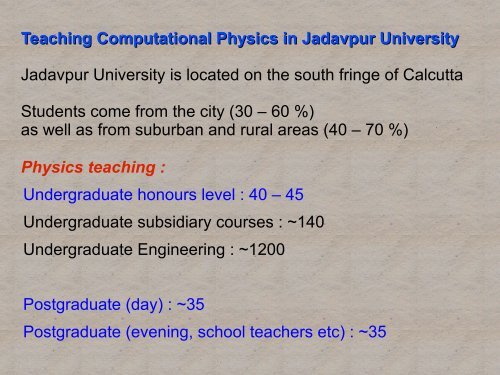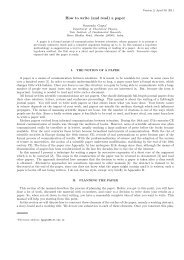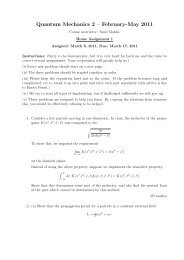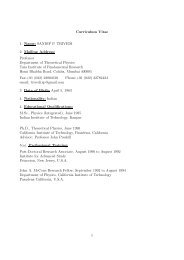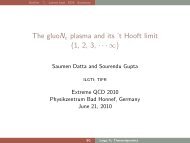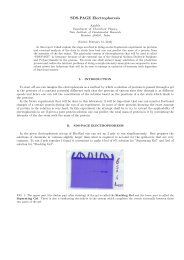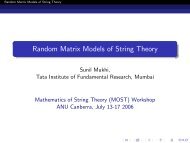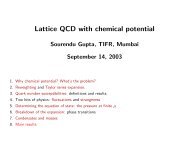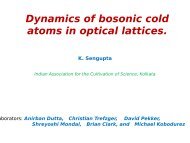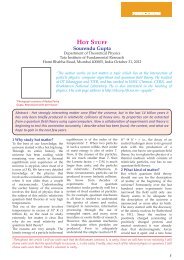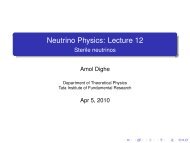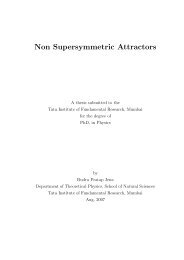Numerical Analysis in Jadavpur University
Numerical Analysis in Jadavpur University
Numerical Analysis in Jadavpur University
Create successful ePaper yourself
Turn your PDF publications into a flip-book with our unique Google optimized e-Paper software.
Teach<strong>in</strong>g Computational Physics <strong>in</strong> <strong>Jadavpur</strong> <strong>University</strong><br />
<strong>Jadavpur</strong> <strong>University</strong> is located on the south fr<strong>in</strong>ge of Calcutta<br />
Students come from the city (30 – 60 %)<br />
as well as from suburban and rural areas (40 – 70 %)<br />
Physics teach<strong>in</strong>g :<br />
Undergraduate honours level : 40 – 45<br />
Undergraduate subsidiary courses : ~140<br />
Undergraduate Eng<strong>in</strong>eer<strong>in</strong>g : ~1200<br />
Postgraduate (day) : ~35<br />
Postgraduate (even<strong>in</strong>g, school teachers etc) : ~35
Undergraduate teach<strong>in</strong>g <strong>in</strong>cludes :<br />
2 semester course <strong>in</strong> computer applications → 2 nd Year B.Sc.<br />
Till 1999 – Introduction to Fortran<br />
From 2000 – Introduction to C
Undergraduate teach<strong>in</strong>g <strong>in</strong>cludes :<br />
2 semester course <strong>in</strong> computer applications → 2 nd Year B.Sc.<br />
Till 1999 – Introduction to Fortran<br />
From 2000 – Introduction to C<br />
Advantage : Basic course, compulsory to all science students,<br />
<strong>in</strong>terdepartmental <strong>in</strong>itiative
Undergraduate teach<strong>in</strong>g <strong>in</strong>cludes :<br />
2 semester course <strong>in</strong> computer applications → 2 nd Year B.Sc.<br />
Till 1999 – Introduction to Fortran<br />
From 2000 – Introduction to C<br />
Advantage : Basic course, compulsory to all science students,<br />
<strong>in</strong>terdepartmental <strong>in</strong>itiative<br />
Disadvantage : No Major-subject specific tailor<strong>in</strong>g,<br />
Not enough application <strong>in</strong> the major (honours)<br />
subject
Postgraduate teach<strong>in</strong>g <strong>in</strong>cludes :<br />
2 semester course <strong>in</strong> Fortran Programm<strong>in</strong>g and<br />
<strong>Numerical</strong> Methods → 1 st Year (s<strong>in</strong>ce 1988)<br />
Errors <strong>in</strong> numerical computation<br />
Solutions of equations : Bisection, Secant, Newton-Raphson<br />
Method.<br />
F<strong>in</strong>ite Differences<br />
Newton and Lagrange <strong>in</strong>terpolation<br />
Euler method, Runge-Kutta method<br />
Method of least squares<br />
Matrix eigenvalues<br />
<strong>Numerical</strong> <strong>in</strong>tegration : Trapezoidal and Simpson's method
Postgraduate teach<strong>in</strong>g <strong>in</strong>cludes :<br />
2 semester course : Computer Applications → 2 nd Year M.Sc.<br />
<strong>in</strong> Physics (s<strong>in</strong>ce 1995,<br />
UGC special assistance)
Postgraduate teach<strong>in</strong>g <strong>in</strong>cludes :<br />
2 semester course : Computer Applications → 2 nd Year M.Sc.<br />
<strong>in</strong> Physics (s<strong>in</strong>ce 1995,<br />
UGC special assistance)<br />
1 Review of Fortran<br />
2 Introduction to Mathematica
Postgraduate teach<strong>in</strong>g <strong>in</strong>cludes :<br />
2 semester course : Computer Applications → 2 nd Year M.Sc.<br />
<strong>in</strong> Physics (s<strong>in</strong>ce 1995,<br />
UGC special assistance)<br />
1 Review of Fortran<br />
2 Introduction to Mathematica<br />
3 Classical Mechanics
Postgraduate teach<strong>in</strong>g <strong>in</strong>cludes :<br />
2 semester course : Computer Applications → 2 nd Year M.Sc.<br />
<strong>in</strong> Physics (s<strong>in</strong>ce 1995,<br />
UGC special assistance)<br />
1 Review of Fortran<br />
2 Introduction to Mathematica<br />
3 Classical Mechanics – Motion of po<strong>in</strong>t particle, Orbits <strong>in</strong><br />
central force field, solution of Hamilton's equation,<br />
non-l<strong>in</strong>ear dynamics, Bifurcations, Duff<strong>in</strong>g oscillator,<br />
van-der Pol oscillator, Lorenz equation, Chaos.
Postgraduate teach<strong>in</strong>g <strong>in</strong>cludes :<br />
2 semester course : Computer Applications → 2 nd Year M.Sc.<br />
<strong>in</strong> Physics (s<strong>in</strong>ce 1995,<br />
UGC special assistance)<br />
1 Review of Fortran<br />
2 Introduction to Mathematica<br />
3 Classical Mechanics – Motion of po<strong>in</strong>t particle, Orbits <strong>in</strong><br />
central force field, solution of Hamilton's equation,<br />
non-l<strong>in</strong>ear dynamics, Bifurcations, Duff<strong>in</strong>g oscillator,<br />
van-der Pol oscillator, Lorenz equation, Chaos.<br />
4 Quantum Mechanics
Postgraduate teach<strong>in</strong>g <strong>in</strong>cludes :<br />
2 semester course : Computer Applications → 2 nd Year M.Sc.<br />
<strong>in</strong> Physics (s<strong>in</strong>ce 1995,<br />
UGC special assistance)<br />
1 Review of Fortran<br />
2 Introduction to Mathematica<br />
3 Classical Mechanics – Motion of po<strong>in</strong>t particle, Orbits <strong>in</strong><br />
central force field, solution of Hamilton's equation,<br />
non-l<strong>in</strong>ear dynamics, Bifurcations, Duff<strong>in</strong>g oscillator,<br />
van-der Pol oscillator, Lorenz equation, Chaos.<br />
4 Quantum Mechanics – Time evolution of wave packet,<br />
Bound state energies and wave function, scatter<strong>in</strong>g of<br />
wave packet at potential step.
Postgraduate teach<strong>in</strong>g <strong>in</strong>cludes :<br />
2 semester course : Computer Applications → 2 nd Year M.Sc.<br />
<strong>in</strong> Physics (s<strong>in</strong>ce 1995,<br />
UGC special assistance)<br />
5 Statistical Physics
Postgraduate teach<strong>in</strong>g <strong>in</strong>cludes :<br />
2 semester course : Computer Applications → 2 nd Year M.Sc.<br />
<strong>in</strong> Physics (s<strong>in</strong>ce 1995,<br />
UGC special assistance)<br />
5 Statistical Physics – Random numbers and variables,<br />
Monte Carlo simulation, random walks, approach to<br />
equilibrium, Metropolis algorithm, Is<strong>in</strong>g model
Impact of the course on students – some <strong>in</strong>stances
Impact of the course on students – some <strong>in</strong>stances<br />
Deepak Kar – B.Sc. and M.Sc. (JU) – 2003<br />
Feels the “Comput'l Phys” course as one of<br />
the best he had at JU<br />
Ph. D. Univ of Florida at Ga<strong>in</strong>esville, 2008.<br />
Present : post doc at T.U., Dresden
Impact of the course on students – some <strong>in</strong>stances<br />
Deepak Kar – B.Sc. and M.Sc. (JU) – 2003<br />
Feels the “Comput'l Phys” course as one of<br />
the best he had at JU<br />
Ph. D. Univ of Florida at Ga<strong>in</strong>esville, 2008.<br />
Present : post doc at T.U., Dresden<br />
Rupsi Chandra – B.Sc. (other univ) and M.Sc. (JU) – 2003<br />
Comput'l Phys Proj: Chaos <strong>in</strong> Dynamical Systems<br />
Ph.D. Univ of Delaware, 2008.<br />
Present : post doc at Naval Research Lab
Impact of the course on students – some <strong>in</strong>stances<br />
Deepak Kar – B.Sc. and M.Sc. (JU) – 2003<br />
Feels the “Comput'l Phys” course as one of<br />
the best he had at JU<br />
Ph. D. Univ of Florida at Ga<strong>in</strong>esville, 2008.<br />
Present : post doc at T.U., Dresden<br />
Rupsi Chandra – B.Sc. (other univ) and M.Sc. (JU) – 2003<br />
Comput'l Phys Proj: Chaos <strong>in</strong> Dynamical Systems<br />
Ph.D. Univ of Delaware, 2008.<br />
Present : post doc at Naval Research Lab<br />
Baisakhi Mal – B.Sc. and M.Sc. (JU) – 2006<br />
Comput'l Phys Proj : Surface Growth –<br />
Ballistic-Random Deposition Process<br />
Present : Research fellow at <strong>Jadavpur</strong> <strong>University</strong>
Impact of the course on students – social relevance
Impact of the course on students – social relevance<br />
Maitreyi Banerjee – B.Sc. (CU) – 1987<br />
discont<strong>in</strong>ued study for rais<strong>in</strong>g family,<br />
M.Sc. (JU, even<strong>in</strong>g) – 2004<br />
Presently with Lucent Technologies.
Impact of the course on students – social relevance<br />
Maitreyi Banerjee – B.Sc. (CU) – 1987<br />
discont<strong>in</strong>ued study for rais<strong>in</strong>g family,<br />
M.Sc. (JU, even<strong>in</strong>g) – 2004<br />
Presently with Lucent Technologies.<br />
● While study<strong>in</strong>g central force orbits could not f<strong>in</strong>d any orbit<br />
agree<strong>in</strong>g with some shown <strong>in</strong> Goldste<strong>in</strong>.
Impact of the course on students – social relevance<br />
Maitreyi Banerjee – B.Sc. (CU) – 1987<br />
discont<strong>in</strong>ued study for rais<strong>in</strong>g family,<br />
M.Sc. (JU, even<strong>in</strong>g) – 2004<br />
Presently with Lucent Technologies.<br />
● While study<strong>in</strong>g central force orbits could not f<strong>in</strong>d any orbit<br />
agree<strong>in</strong>g with some shown <strong>in</strong> Goldste<strong>in</strong>.<br />
● This computation <strong>in</strong>spired us to show analytically that some<br />
of the orbits presented <strong>in</strong> Goldste<strong>in</strong> are impossible.
Impact of the course on students – social relevance<br />
Maitreyi Banerjee – B.Sc. (CU) – 1987<br />
discont<strong>in</strong>ued study for rais<strong>in</strong>g family,<br />
M.Sc. (JU, even<strong>in</strong>g) – 2004<br />
Presently with Lucent Technologies.<br />
● While study<strong>in</strong>g central force orbits could not f<strong>in</strong>d any orbit<br />
agree<strong>in</strong>g with some shown <strong>in</strong> Goldste<strong>in</strong>.<br />
● This computation <strong>in</strong>spired us to show analytically that some<br />
of the orbits presented <strong>in</strong> Goldste<strong>in</strong> are impossible.<br />
● Some analytical results were also found for general<br />
power law forces.<br />
“Orbits <strong>in</strong> a central force field : Bounded orbits” - arvix.org/abs/physics/0410149v1<br />
cited by J. T. Wheeler <strong>in</strong> E<strong>in</strong>ste<strong>in</strong> Centennial Review <strong>in</strong> Canadian Journal<br />
of Physics 83(2) 2005, p91. Also <strong>in</strong> http://arXiv.org:physics/0511054
Impact of the course on students – social relevance<br />
An<strong>in</strong>dya Chatterjee – B.Sc. Presidency College (CU) 1988.<br />
Taught <strong>in</strong> a school<br />
M.Sc. (JU, even<strong>in</strong>g), 2004<br />
Presently Headmaster <strong>in</strong> a Calcutta school.
Impact of the course on students – social relevance<br />
An<strong>in</strong>dya Chatterjee – B.Sc. Presidency College (CU) 1988.<br />
Taught <strong>in</strong> a school<br />
M.Sc. (JU, even<strong>in</strong>g), 2004<br />
Presently Headmaster <strong>in</strong> a Calcutta school.<br />
● Introduced to computer use <strong>in</strong> M.Sc.
Impact of the course on students – social relevance<br />
An<strong>in</strong>dya Chatterjee – B.Sc. Presidency College (CU) 1988.<br />
Taught <strong>in</strong> a school<br />
M.Sc. (JU, even<strong>in</strong>g), 2004<br />
Presently Headmaster <strong>in</strong> a Calcutta school.<br />
● Introduced to computer use <strong>in</strong> M.Sc.<br />
● Implemented computer laboratory ( 12 computers) <strong>in</strong> school<br />
with assistance from alumni and NGO.
Impact of the course on students – social relevance<br />
An<strong>in</strong>dya Chatterjee – B.Sc. Presidency College (CU) 1988.<br />
Taught <strong>in</strong> a school<br />
M.Sc. (JU, even<strong>in</strong>g), 2004<br />
Presently Headmaster <strong>in</strong> a Calcutta school.<br />
● Introduced to computer use <strong>in</strong> M.Sc.<br />
● Implemented computer laboratory ( 12 computers) <strong>in</strong> school<br />
with assistance from alumni and NGO.<br />
● Introduced a Computer Applications course for school students.<br />
It is an optional course at secondary level <strong>in</strong> WB .<br />
● Students can also play with applets as an aid to their<br />
school books.
Limitations :<br />
Our courses teach standard methods without handl<strong>in</strong>g<br />
some of the tricky (critical) questions from students.
Limitations :<br />
Our courses teach standard methods without handl<strong>in</strong>g<br />
some of the tricky (critical) questions from students.<br />
1. Why does the same program give different results when<br />
run on different mach<strong>in</strong>es ?
Limitations :<br />
Our courses teach standard methods without handl<strong>in</strong>g<br />
some of the tricky (critical) questions from students.<br />
1. Why does the same program give different results when<br />
run on different mach<strong>in</strong>es ?<br />
2. How much time will my program take ?
Limitations :<br />
Our courses teach standard methods without handl<strong>in</strong>g<br />
some of the tricky (critical) questions from students.<br />
1. Why does the same program give different results when<br />
run on different mach<strong>in</strong>es ?<br />
2. How much time will my program take ?<br />
3. How do I calculate the factorial of a large number ?
Limitations :<br />
Our courses teach standard methods without handl<strong>in</strong>g<br />
some of the tricky (critical) questions from students.<br />
1. Why does the same program give different results when<br />
run on different mach<strong>in</strong>es ?<br />
2. How much time will my program take ?<br />
3. How do I calculate the factorial of a large number ?<br />
4. After a curve fitt<strong>in</strong>g / <strong>in</strong>terpolation, how do I estimate the<br />
error <strong>in</strong>herent (error bars) ?
Limitations :<br />
Our courses teach standard methods without handl<strong>in</strong>g<br />
some of the tricky (critical) questions from students.<br />
1. Why does the same program give different results when<br />
run on different mach<strong>in</strong>es ?<br />
2. How much time will my program take ?<br />
3. How do I calculate the factorial of a large number ?<br />
4. After a curve fitt<strong>in</strong>g / <strong>in</strong>terpolation, how do I estimate the<br />
error <strong>in</strong>herent (error bars) ?<br />
5. How good are my random numbers ? (Chi sq. test etc.)
These limitations - not unique to computer applications :
These limitations - not unique to computer applications :<br />
1. Quantum Mech –<br />
i ) Do we really need Hilbert spaces? Is l<strong>in</strong>ear space enough?
These limitations - not unique to computer applications :<br />
1. Quantum Mech –<br />
i ) Do we really need Hilbert spaces? Is l<strong>in</strong>ear space enough?<br />
ii) Do we need Hermitian operators just to ensure real<br />
eigenvalues, or are there deeper reasons ?
These limitations - not unique to computer applications :<br />
1. Quantum Mech –<br />
i ) Do we really need Hilbert spaces? Is l<strong>in</strong>ear space enough?<br />
ii) Do we need Hermitian operators just to ensure real<br />
eigenvalues, or are there deeper reasons ?<br />
iii) Is bra vector just an adjo<strong>in</strong>t (transpose conjugate) of ket ?<br />
2. Statistical Mechanics –<br />
i ) Product of an <strong>in</strong>creas<strong>in</strong>g and a decreas<strong>in</strong>g function<br />
has a maximum. Is that always true ?
These limitations - not unique to computer applications :<br />
1. Quantum Mech –<br />
i ) Do we really need Hilbert spaces? Is l<strong>in</strong>ear space enough?<br />
ii) Do we need Hermitian operators just to ensure real<br />
eigenvalues, or are there deeper reasons ?<br />
iii) Is bra vector just an adjo<strong>in</strong>t (transpose conjugate) of ket ?<br />
2. Statistical Mechanics –<br />
i ) Product of an <strong>in</strong>creas<strong>in</strong>g and a decreas<strong>in</strong>g function<br />
has a maximum. Is that always true ?<br />
3. Classical mechanics –<br />
i ) How do we def<strong>in</strong>e virtual displacement ?<br />
Is pr<strong>in</strong>ciple of zero virtual work a def<strong>in</strong>ition (it is not), or an<br />
additional condition on the system of virtual displacements ?
What do I expect from a meet<strong>in</strong>g like the present one :<br />
Exchange experience and ideas (may cont<strong>in</strong>ue through email)<br />
Discuss common core curricula<br />
Evolve realistic and effective method of feedback from students<br />
Hold discussion sessions for cont<strong>in</strong>uous improvement <strong>in</strong> future
Learn<strong>in</strong>g physics is sometimes like<br />
travers<strong>in</strong>g a rough road through<br />
beautiful places.
There will always be twists and<br />
turns, but a paved road can lead<br />
to more exotic beauty of nature.<br />
Learn<strong>in</strong>g physics is sometimes like<br />
travers<strong>in</strong>g a rough road through<br />
beautiful places.


